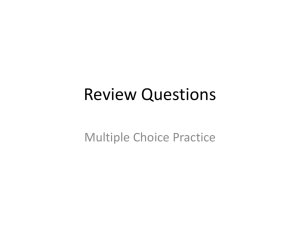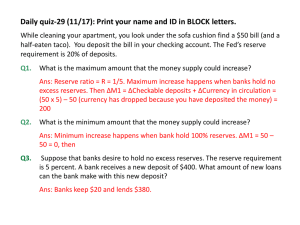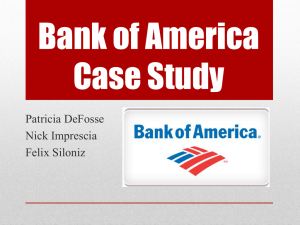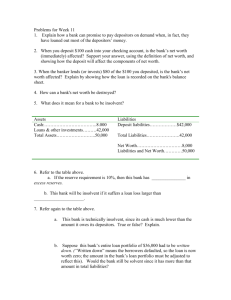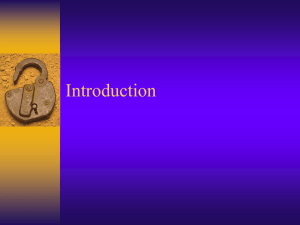Economics 135 Money Supply Process Professor Kevin D. Salyer Spring 2009
advertisement
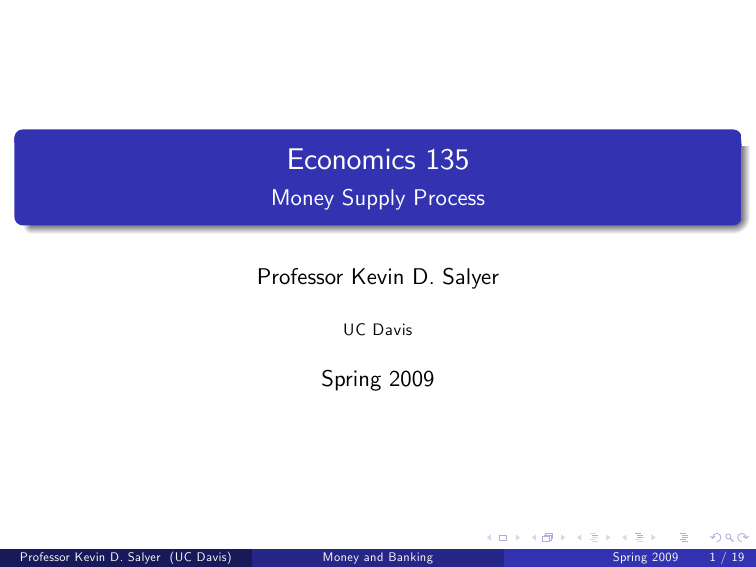
Economics 135 Money Supply Process Professor Kevin D. Salyer UC Davis Spring 2009 Professor Kevin D. Salyer (UC Davis) Money and Banking Spring 2009 1 / 19 The Money Supply Process: The Role of the Fed, Banks, and the Private Sector It is the Fed who puts the money into the system and the monetary component it supplies is called high-powered money. This is what the Fed directly controls, but it is not the money supply. The high-powered money ends up in two places - the vaults of the banks as reserves, or the pockets of people and businesses as cash. The cash held by the banks is called reserves and these reserves are the base for banks’expansion of checking accounts. If you add the currency held by the public with the deposit (checking) accounts created by the banks, you have the money supply. Professor Kevin D. Salyer (UC Davis) Money and Banking 03/06 2 / 19 A schematic of the money supply process Professor Kevin D. Salyer (UC Davis) Money and Banking 03/06 3 / 19 Money supply - the fractional reserve system Professor Kevin D. Salyer (UC Davis) Money and Banking 03/06 4 / 19 Banks and the money supply process Three important features of the system are: Bank pro…tability: banks are in business for pro…t. Bank discretion over money supply: bankers’decisions a¤ect money supply. If bankers decide to increase the value of demand deposits then the money supply will increase. If they increase their holdings of excess reserves the money supply will decrease. Exposure to runs: potential con‡ict between pro…ts and safety. The banks will be tempted to expand the demand deposits which will mean that if all depositors wanted their cash, the banks could not honor the claims. Professor Kevin D. Salyer (UC Davis) Money and Banking 03/06 5 / 19 Regulatory Response The four important aspects of bank regulation are: Deposit insurance: deposits are insured which lowers the fears of customers who will not be as likely to run to the bank to withdraw their funds when they hear a "rumor" about the bank. Bank examinations: banks’books are periodically reviewed so that we are less likely to have banks that adopting risky strategies that will result in bank closures. Limitations on assets: banks cannot hold some assets that are deemed risky. International standards: the Basel Accord I and II. Problem: o¤-balance sheet activities such as …rm loan commitments,standby letters of credit, …nancial futures, forward contracts, options, interest rate swap contracts, and other derivative products. Required reserves: banks required to keep cash on hand. This would limit the amount of money that could be created from a given amount of reserves. Professor Kevin D. Salyer (UC Davis) Money and Banking 03/06 6 / 19 The Federal Reserve System Professor Kevin D. Salyer (UC Davis) Money and Banking 03/06 7 / 19 Today, the Federal Reserve’s duties fall into four general areas: 1 Conducting the nation’s monetary policy by in‡uencing the money and credit conditions in the economy in pursuit of full employment and stable prices. 2 Supervising and regulating banking institutions to ensure the safety and soundness of the nation’s banking and …nancial system and to protect the credit rights of consumers (Federal Reserve Regulations). 3 Maintaining the stability of the …nancial system and containing systemic risk that may arise in …nancial markets. 4 Providing certain …nancial services to the U.S. government, to the public, to …nancial institutions, and to foreign o¢ cial institutions, including playing a major role in operating the nation’s payments system. Professor Kevin D. Salyer (UC Davis) Money and Banking 03/06 8 / 19 Money Supply Example Begin with a simple balance sheet for the ACM bank. We will assume the bank’s assets consist of cash (reserves), loans, and government securities. Banks will hold government securities and loans because they earn interest. Also government securities are liquid assets. In this example we are assuming the Fed is requiring the bank to hold 20 percent of the amount of its deposit accounts as cash (reserves). To "support" the $5,000,000 in checking account balances, the bank will be required to hold $1,000,000 as required reserves Professor Kevin D. Salyer (UC Davis) Money and Banking 03/06 9 / 19 Current Reserve Requirement in U.S. Type of Liability Transactions Accounts 0 - $8.5 (millions $8.5 -$ 45.8 $45.8 < Percentage of Liability Nonpersonal Time Deposits 0 Eurocurrency Liabilities 0 Professor Kevin D. Salyer (UC Davis) Money and Banking 0 3 10 03/06 10 / 19 ACM’s Initial Balance Sheet Assets Securities Reserves Actual Required Excess Loans Total Liabilities $500,000 $1,000,000 $1,000,000 $0 $4,000,000 $5,500,000 Professor Kevin D. Salyer (UC Davis) Checking Deposit Saving Deposit Net Worth Money and Banking $5,000,000 $0 $500,000 $5,500,000 03/06 11 / 19 Mary Deposits $100,000 (where did this come from?) Assets Securities Reserves Actual Required Excess Loans Total Bank ACM Balance Sheet Liabilities $500,000 Checking Deposit $1,100,000 Saving Deposit $1,020,000 Net Worth $80,000 $4,000,000 $5,600,000 Professor Kevin D. Salyer (UC Davis) Money and Banking $5,100,000 $0 $500,000 $5,600,000 03/06 12 / 19 Banks want to make pro…ts: lend out excess reserves ACM bank lends out $80,000 of excess reserves in form of cash (reserves fall by $80,000 and loans rise by $80,000) $80,000 will work its way back into the banking system as another infusion of cash - this time an infusion of $80,000 into Bank KAB. Bank ACM Balance Sheet Assets Securities Reserves Actual Required Excess Loans Total Liabilities $500,000 $1,100,000 $1,020,000 $0 $4,080,000 $5,600,000 Professor Kevin D. Salyer (UC Davis) Checking Deposit Saving Deposit Net Worth Money and Banking $5,100,000 $0 $500,000 $5,600,000 03/06 13 / 19 KAB’s books after deposit of $80,000 Bank KAB’s balance sheet Assets Securities Reserves Actual Required Excess Loans Total Professor Kevin D. Salyer (UC Davis) Liabilities $0 $80,000 $16,000 $64,000 $0 $80,000 Checking Deposit Saving Deposit Net Worth Money and Banking $80,000 $0 $0 $80,000 03/06 14 / 19 KAB’s books after elimination of excess reserves Bank KAB’s balance sheet Assets Securities Reserves Actual Required Excess Loans Total Professor Kevin D. Salyer (UC Davis) Liabilities $0 $16,000 $16,000 $0 $64,000 $80,000 Checking Deposit Saving Deposit Net Worth Money and Banking $80,000 $0 $0 $80,000 03/06 15 / 19 Money Creation - the e¤ect on individual banks Bank ACM Reserves Loans Bank KAB Reserves Loans Bank MRM Reserves Loans Bank AJM Reserves Loans Bank LRG Reserves Loans Professor Kevin D. Salyer (UC Davis) $20,000 $36,000 Checking Account $100,000 $16,000 $64,000 Checking Account $80,000 $12,800 $51,200 Checking Account $64,000 $10,240 $40,960 Checking Account $51,200 $8,192 $32,768 Checking Account $40,960 Money and Banking 03/06 16 / 19 Money Creation in the Banking System Bank Bank Bank Bank Bank Bank ... Total ACM KAB MRM AJM LRG FTS Professor Kevin D. Salyer (UC Davis) Reserves $20,000 $16,000 $12,800 $10,240 $8,192 $6,554 Deposits $100,000 $80,000 $64,000 $51,200 $40,960 $32,768 Loans $80,000 $64,000 $51,200 $40,960 $32,768 $26,214 $100,000 $500,000 $400,000 Money and Banking 03/06 17 / 19 Fed’s Control of the Money Supply Process The money supply (M1) can be increased if the coins and currency in circulation increase or the checking account balances (demand deposit) increase. There are four ways that this can happen. Required reserve rate is lowered. Discount interest rate decreases. (Lowers cost of holding low excess reserves.) Publics’holding of cash changes. Less con…dence in the banking system = more cash, less reserves => Money supply falls. Example: The injection of reserves into the banking system prior to Y2K. Open market purchases: this is the Fed’s primary tool of monetary policy. The Fed can buy or sell government securities. THIS is how Mary got her money!! Professor Kevin D. Salyer (UC Davis) Money and Banking 03/06 18 / 19
